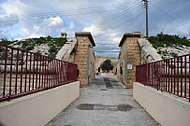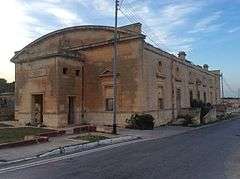Pembroke Army Garrison
| Pembroke Garrison | |
|---|---|
| Pembroke, Malta | |
| Type | Fortifications, Barracks, military families' quarters and Wartime Military Hospitals in WW1 and WW2 |
| Height | Low rise |
| Site information | |
| Owner | Government of Malta |
| Controlled by | Pembroke Town Council |
| Condition | Largely intact with some derelict buildings |
| Site history | |
| Built | 1862 with several development phases up til 1941 |
| Built by | British Empire |
| In use | 1869–1977 |
| Materials | Limestone |
| Battles/wars | Logistic and medical support to World War 1 and the Siege of Malta (World War II) |
Pembroke Garrison is a dispersed collection of former British Army barracks built in the vicinity of Fort Pembroke[1], northern Malta.
History
Pembroke Garrison developed around a Victorian fortification (Fort Pembroke), a gun emplacement, a barracks, a tented musketry camp, rifle ranges and training areas. St George's Barracks[2] was built first, followed by Fort Pembroke, then St Andrew's Barracks and finally St Patrick's Barracks; built by the British in four main building phases 19th and 20th Centuries.[3] Part of the garrison (St Andrew's Barracks) were used as a Military hospital during the First World War[4]; during the First World War Malta's military hospitals and convalescent camps, particularly those at Pembrokedealt with over 135,000 sick and wounded, most of whom were casualties of the Gallipoli and Salonika campaigns[5]. It remained in use by the British military until 1977.[6] St Patrick's Barracks was not constructed until World War Two.[7]

Army units based at Pembroke Garrison between 1954 and 1967 would have been subordinate to Headquarters Malta and Libya.[8]
At the height of is occupancy the British garrison at Pembroke included St George's[9], St Patrick's[10] and St Andrew's Barracks[11], places of worship[12], firing ranges and Fort Pembroke itself; as well as a military repair base, a medical centre, a military cemetery[13], a garrison school[14] and other soldier and family welfare facilities (i.e. a NAAFI shop, beach club (the 'Robb Lido'[15]) and regimental messes).
In May 1940 naval and army families living on the island were moved to Pembroke Garrison (into St George's and St Andrew's Barracks).[16] Once St Patrick's barracks were constructed in 1941 Pembroke Garrison would be a critical medical support base for the island.[17]




British Army and RM units known to have been based at Pembroke Garrison
This is not an exhaustive list of the units that occupied the Pembroke Garrison, but it represents those that are recorded:
- St Georges Barracks - constructed between 1859 and 1862
- The Gloucestershire Regiment - 1913
- The South Staffordshire Regiment - 1928[18]
- The Cheshire Regiment - 1932
- 1st Battalion the Suffolk Regiment - 1937 to 1939[19]
- 40 Commando RM - 1949[20]
- 8 Commando Light Battery RA - 1976
- St Andrew's Barracks - not occupied until April 1905[21]
- 39 General Hospital RAMC - arrived from UK in 1941[22]
- 2nd Battalion The King's Own Malta Regiment, acting as a POW guard force at No1 (Malta) Prisoner of War Camp at Pembroke
- 45 Commando RM - 1952 Arrived from Malaya[23]
- 40 Commando RM - 1957[24]
- 1st Battalion the Royal Sussex Regiment - 1963-1966
- 41 Commando RM - 1977[25]
- St Paul's Hutments
- Sick Soldiers' Hospital and Convalescent Camp[26]
- 53 Command Workshops REME - present during WW2 and up to the 1970s[27][28]
- St Patrick's Barracks - constructed in 1941
- 45 General Hospital RAMC - arrived from UK in 1941[29]
- 45 Commando RM - May 1947 and December 1948[30]
- 37 Heavy Anti-Aircraft Regiment RA - 1956[31]
- 4th (Leicestershire) Battalion the Royal Anglian Regiment - 1967.[32]
Although the Pembroke Garrison was nominally and Army facility able to house three infantry battalions, it is clear that the Royal Marines had a long post-war association with Pembroke.
Transfer of ownership to the Maltese Government
The bulk of the garrison's sites were decommissioned and handed to the Government of Malta in 1977. The barracks and their environs are now divided into a thriving community of Pembroke made up public and private housing; and a number of notable colleges and schools, many of them located in re-purposed original British Army barrack blocks.[33]
The Limestone Karst countryside around promotes a unique ecology called Garigue which the local authorities are keen to promote as a visitor attraction, along with the military heritage.[34]
- Legacy Pembroke site reuse noted
- St George's Barracks (part of) - Institute of Tourism Studies.[35]
- Fort Pembroke and St Andrew's Barracks (part of) - the Verdala International School Malta.[36]
- Pembroke Battery site - all but one emplacement redeveloped as housing.
- St Andrews Barracks (part of) - Pembroke Local Council[37]
- St Andrew's Barracks (part of i.e. Block A, Alamein Road) - Middlesex University Malta[38]
- St Andrew's Barracks (part of i.e. Block D, Giorgio Mitrovich Street) - STC training college.[39]
- St Andrew's Barracks (part of) - St Michael's School.[40]
- St Andrew's Barracks (part of) - Sprachcaffe residential language school[41]
- St Andrew's Garrison School and the barrack's sports pitches - The National Sports School[42]
- St Patrick's Barracks (part of) - St Clare College[43].
St George's Barracks (the oldest of Pembroke Garrison's unit location) has not survived intact (as did St Andrew's and St Patrick's) and this probably reflects the fact that after British withdrawal from Malta there was not the imperative and funds that there is now to preserve and utilise heritage imperial building stock. Australia House[44], the former REME workshops and the White Rocks Officers' Quarters [45]areas are still in need of development and restoration.
See also
- Fort Pembroke
- Pembroke Battery
- Fort Madalena
- Siege of Malta (World War II)
- Mediterranean Fleet
- Malta at War Museum
- Armed Forces of Malta
- Fortifications of Malta
- Paceville
External links
- Pembroke Council Malta Website
- Pembroke Military Cemetery Burials Index
- Malta 1930 - 1945
- Nature Trust Malta Pembroke
- Institute of Tourism Studies
References
- ↑ Darmanin, Denis A (2010). Pembroke From a British Garrison to a Modern Civilian Town. ISBN 9789993208631.
- ↑ "Military Hospitals of the Malta Garrison - Pembroke Camp District - Forrest Hospital St Julian's". archive.li. 11 January 2016. Retrieved 9 July 2017.
- ↑ "About Pembroke". www.maltatogo.org. Retrieved 9 July 2017.
- ↑ "The ANZAC experience in Malta - Page 7" (PDF). Australian High Commission Valletta. Retrieved 8 July 2017.
- ↑ "Military Cemetery, Pembroke". Protecting the most significant buildings, monuments and features. MEPA. Retrieved 11 July 2017.
- ↑ Ltd, Allied Newspapers. "Pembroke: from war symbol to spacious modern town". Times of Malta. Retrieved 8 July 2017.
- ↑ "Malta Garrison 1941". maltaramc.com. Retrieved 8 July 2017.
- ↑ UK, The National Archives. "War Office, Headquarters Malta and Libya". discovery.nationalarchives.gov.uk. UK Government. Retrieved 10 July 2017.
- ↑ Archives, The National. "St George's Barracks, Malta". discovery.nationalarchives.gov.uk. Suffolk Regiment Archives. Retrieved 8 July 2017.
- ↑ Ltd, Allied Newspapers (11 February 2010). "Protecting the most significant buildings, monuments and features of Pembroke (9)". Times of Malta. Retrieved 8 July 2017.
- ↑ "St Andrew's Barracks". MEPA. Retrieved 8 July 2017.
- ↑ Archives, The National. "Christ Church, Pembroke Garrison, Malta". discovery.nationalarchives.gov.uk. Retrieved 8 July 2017.
- ↑ "PEMBROKE MILITARY CEMETERY". Cemetery Details. CWGC. Retrieved 8 July 2017.
- ↑ "Malta Garrison 1903 - Army Education Department, List of School Masters/Mistresses". maltaramc.com. Retrieved 8 July 2017.
- ↑ "Environment and Transport World, Pages 6 & 7" (PDF). The Department of the Environment and the Department of Transport. Retrieved 10 July 2017.
- ↑ "Malta Garrison 1940 - Medical Aid Posts". maltaramc.com. Retrieved 8 July 2017.
- ↑ "Malta Garrison 1941". maltaramc.com. Retrieved 8 July 2017.
- ↑ Leese, James (2013). Going for a Soldier. Lulu.com. pp. 49–50. ISBN 9781291407334.
- ↑ Archives, The National. "The Suffolk Regiment at St George's Barracks, Malta". discovery.nationalarchives.gov.uk. The Suffolk Regt. Retrieved 8 July 2017.
- ↑ "40 Commando RM, 'A' Troop, July 1949.". gallery.commandoveterans.org. Retrieved 9 July 2017.
- ↑ "Malta Garrison 1905 - Barracks". maltaramc.com. Retrieved 9 July 2017.
- ↑ "Malta Garrison 1941". maltaramc.com. Retrieved 8 July 2017.
- ↑ "The Royal Marines". maltaramc.com. Retrieved 9 July 2017.
- ↑ "X Troop St Andrews Barracks Malta 1957". www.40commandoassociation.com. Retrieved 8 July 2017.
- ↑ "About Pembroke". www.maltatogo.org. Retrieved 9 July 2017.
- ↑ "St Paul's Hutments". MEPA. Retrieved 11 July 2017.
- ↑ "Mercury" (PDF). Royal Signals Amateur Radio Society. 31: 36. Spring 1970. Retrieved 8 July 2017.
- ↑ Allied, Newspapers (13 April 2003). "Their skills helped to defend Malta". Times of Malta. Retrieved 9 July 2017.
- ↑ "Malta Garrison 1941". maltaramc.com. Retrieved 8 July 2017.
- ↑ "The Royal Marines". maltaramc.com. Retrieved 9 July 2017.
- ↑ "36 Regt RA Associated Units". www.36reg.com. Retrieved 8 July 2017.
- ↑ "Royal Leicestershire Regiment - Looking back - Various photos page 1". sites.google.com. Retrieved 9 July 2017.
- ↑ Mitev, Georgi. "Pembroke, Malta - Information and interests". www.malta.com. Retrieved 8 July 2017.
- ↑ "Pembroke Heritage Project - Visitors' Site Guide". issuu. Pembroke Heritage Project. Retrieved 8 July 2017.
- ↑ "Contact Us". www.its.edu.mt. ITS Malta. Retrieved 10 July 2017.
- ↑ "Verdala International School Malta - VIS Malta". www.verdala.org. Retrieved 10 July 2017.
- ↑ "Kunsill Lokali Pembroke - Dħul". www.pembroke.gov.mt. Retrieved 10 July 2017.
- ↑ "Malta | Middlesex University London". www.mdx.ac.uk. Retrieved 10 July 2017.
- ↑ "Home". STC Higher Education. Retrieved 10 July 2017.
- ↑ "Home". www.stmeduc.org. Retrieved 10 July 2017.
- ↑ Malta, Sprachcaffe. "Sprachcaffe Malta". www.sprachcaffe-malta.com. Retrieved 11 July 2017.
- ↑ "National Sport School". nss.skola.edu.mt. Retrieved 10 July 2017.
- ↑ "St Clare College Pembroke Secondary School". edumalta.gov.mt. Retrieved 10 July 2017.
- ↑ "The Ruined Australia Hall in Pembroke, Malta - Urban Ghosts Media". Urban Ghosts Media. 7 June 2017. Retrieved 10 July 2017.
- ↑ "White Rocks project hits the rocks". MaltaToday.com.mt. Retrieved 10 July 2017.